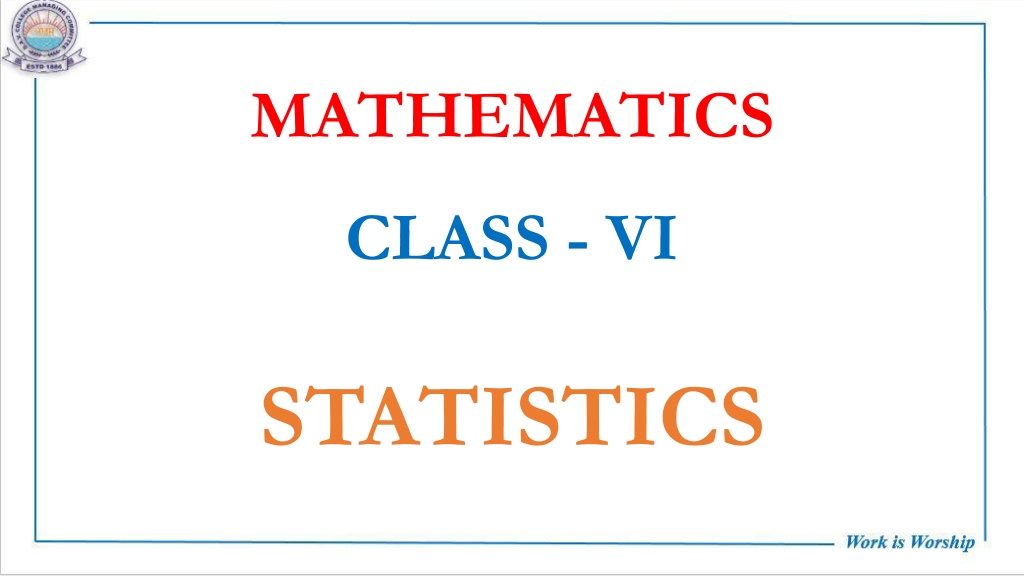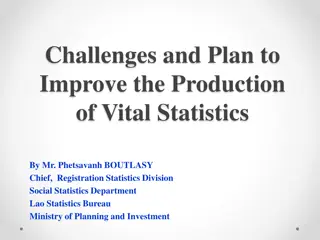Understanding Statistics in Mathematics Class VI
Learn about data collection, organization, and representation in a Class VI Mathematics statistics chapter. Discover the importance of tally marks, pictographs, and bar graphs for visualizing data through real-life examples like tracking COVID-19 cases and student test scores.
Download Presentation

Please find below an Image/Link to download the presentation.
The content on the website is provided AS IS for your information and personal use only. It may not be sold, licensed, or shared on other websites without obtaining consent from the author. Download presentation by click this link. If you encounter any issues during the download, it is possible that the publisher has removed the file from their server.
E N D
Presentation Transcript
MATHEMATICS CLASS - VI STATISTICS
PDF CHAPTER LINK https://drive.google.com/file/d/1wUWL 0pUG- o7zOMaVLi1wHJ1BLjceZMOJ/view Click on the above link to access the PDF of the chapter.
LEARNING OBJECTIVES Understand the term Data and Raw data Collect and organise the data Arrange the data in a table using Tally Marks Represent the data in the form of pictures Represent the data by using bars Interpret the Bar Graph Prepare a Bar Graph
INTRODUCTION Everyday we come across many numerical data in newspapers, magazines and on television. Recently, a virus Covid-19 strikes the entire world and infects people across countries in the year 2020. The number of confirmed cases in different countries across the world are given (in thousands) as follows: 39 , 25 , 5 , 33 , 19 , 21 , 16 , 23 , 12 , 18 , 55 , 43 , 13 , 7 , 75 .
Consider the following list of Mathematics Marks (out of 80) scored by 20 students of Class VI in a test. 55, 65, 15, 40, 35, 70, 78, 72, 74, 75 60, 75, 65, 72, 80, 68, 54, 77, 78, 66. We find that each entry in the above list is a numerical fact which is called an Observation. Such a collection of observations gathered to give some information is known as Data.
What is Data? Data is a collection of numbers gathered to give some information. Visual representation of data will help us to understand it better and remember the facts easily. Example The marks obtained by five students of a class are 75, 48, 59, 85, 98.
ORGANISATION OF DATA To get a particular information from the given data quickly ,the data has to be organised first. The organisation of data can be done in various ways. For easy understanding & meaningful comparison, the data is commonly represented as: tabularform using tally marks pictorialform i.e. Pictograph graphicalform i.e. Bar Graph
TALLY MARKS Tally marks are small vertical lines drawn to represent a data. The general way of writing tally marks is as a group or set of five lines. The first four lines are drawn vertically and each of the fifth lines run diagonally over the previous lines. Tally marks are the fastest way of keeping track of a group of five.
ASSIGNMENT 1 The number of different companies shoes are given below. Arrange the data in a table using tally marks. Nike Adidas Reebok Puma 7 13 8 3
ANSWER Shoe Company Number of Shoes Tally Marks Nike 7 Adidas 13 Reebok 8 Puma 3 Marking Scheme Each step carries 0.5 marks. Total Mark 0.5 marks x 4 = 2 marks
PICTOGRAPHS Pictographs represent data through appropriate pictures. In pictographs, the same type of symbol or picture is used to represent the data. Each symbol is used to represent a certain value, and this is mentioned clearly in the graph.
Given below is a pictograph of the number of apples sold by the nearby vendor in the first 4 months of 2020: What does the data represent?
The data represents: Month Number of Apples 10 January 40 February 25 March 20 April
ASSIGNMENT 2 For Van Mahotsav, students of DAV Public School planted different number of plants on five days of a week. The data for different days of the week are given below: Day Number of plants 30 70 60 80 40 Monday Tuesday Wednesday Thursday Friday
ANSWER figure
MODEL ANSWER Content Marks For Correct Scale (Mention) 0.5 marks For Each Correct Step (5 steps) 5 x 0.5 marks = 2.5 marks Total 3 marks
What is a Bar Graph? Bar graph is another way of representing data. This method is easy and less time consuming as compared to pictograph. A bar graph is a pictorial representation of the numerical data by a number of bars of uniform width erected horizontally or vertically with equal spacing between them.
Interpretation of a Bar Graph Y - Axis Runs scored Scale 1 Unit = 20 Runs 120 97 100 91 80 60 Runs scored 40 35 21 18 20 0 0 X - Axis Sehwag Sachin Gambhir Kohli Dhoni Yuvraj This is the bar graph representing the runs scored by Indian batsmen in the World Cup 2011 Final.
How many runs were scored by Kohli? Who has scored the maximum runs? Who has scored the least number (minimum) runs? What was the total runs scored by Indian batsmen? How many batsmen scored more than 30?
ANSWER How many runs were scored by Kohli? Who has scored the maximum runs? Who has scored the least number (minimum) runs? What was the total runs scored by Indian batsmen? How many batsmen scored more than 30? 35 runs Gambhir (97 runs) Sehwag (0 runs) 262 runs 3 batsmen
How to draw a Bar Graph? In order to understand how to draw a bar graph, consider the following data (Information of the number of children in Class VI and their favourite activities). Activity No. of Children Dance 30 Music 40 Art 25 Cricket Football 20 35
How to draw a Bar Graph? Step 1 On a graph, draw two lines perpendicular to each other, intersecting at 0. The horizontal line is X-axis and vertical line is Y-axis. Step 2 Along the horizontal axis, choose the uniform width of bars and uniform gap between the bars and write the names of the data items whose values are to be marked. Step 3 Along the vertical axis, choose a suitable scale in order to determine the heights of the bars for the given values. (Frequency is taken along Y-axis). Step 4 Calculate the heights of the bars according to the scale chosen and draw the bars.
Bar graph gives the information of the number of children involved in different activities. Scale 1 unit length = 10 children 45 35 25 15 5
Let us see how to Draw a Bar Graph! https://www.youtube.com/watch?v=g JOxzKreYrQ&feature=youtu.be Click on the above link to access the video.
ASSIGNMENT 3 The following table shows the circulation of five different newspapers in a city. Prepare a bar graph with a suitable scale. Newspaper No. of Newspapers The Times of India 1200 Indian Express 300 The Economic Times 700 The Hindu 800 The Telegraph 500
ANSWER SCALE 1 UNIT = 200 NEWSPAPERS Y AXIS 1400 1200 1000 No. of News- papers 800 600 400 200 X AXIS 0 Times of India Indian Express The Economic Times Different Newspapers The Hindu The Telegraph
MODEL ANSWER Content Marks 0.5 marks 0.5 marks 0.5 marks For labelling of X - Axis For labelling of Y - Axis For Correct Scale (Mention) For Each Correct Bar (5 bars) Total 5 x 0.5 marks = 2.5 marks 4 marks
ART INTEGRATION Given below are five letters used very frequently.
ART INTEGRATION 1. Based on the previous slide, complete the table given below with tally marks. Tally Table for Letters a e I N O 2. Also, draw a bar graph for the above table by paper cutting and pasting. Tally Marks
LEARNING OUTCOMES The students will be able to : Understand the term data . Represent the data by using tally marks. Represent the data by using pictographs. Read and interpret a bar graph by observing the length of the bars. Construct bar graphs (both horizontal and vertical).
SUMMARY Data is a collection of numbers to give some information. Tally marks are small vertical lines drawn to represent a data. Pictographs represent a given data in the form of pictures. Representation of a data by using bars or rectangles is called bar graph. We can interpret a bar graph by observing the length of the bars. A bar graph can be made horizontally or vertically with equal spacing between the bars of uniform width.
Thank You!























